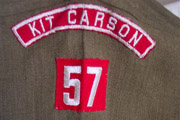Rare South Dakota Cub state strip surfaces
Nearly two years ago Don DeYoung took a poll of state strip collectors and identified five Cub strips unknown in any collection: DEL HAWAII MISS SDAK and WYO (one collector said he had seen a WYO Cub but could not identify the owner). Note that Hawaii and Alaska were not states when these strips were used, but full ALASKA state strips exist in both khaki & red and Explorer colors. The two known Alaska Cub strips say ALAS. I am not aware of full HAWAII state strips existing in any colors but red & white, althought there is a TH khaki & red strip (Territory of Hawaii).
We were able to locate a South Dakota Cub strip and get an image of it, but it was not owned by a national state strip collector. Then in March of 2006 a WYO Cub strip was discovered for sale on eBay in a large frame with other Scout and Cub insignia. The entire frame sold for over $500 and the last bidders were after the state strip only. In May of 2006 a South Dakota Cub strip appeared on eBay with a Sturgis town strip, and this lot sold for over $460. The remaing three unknown Cub strips have not been found to my knowledge. A third South Dakota Cub strip was offered on eBay just recently in August and brought a high bid of $405.
A gauze back PA Explorer strip was sold by TSPA in September of 2007 for over $134. We think gauze back strips of any kind were locally made in small numbers to meet limited demand. It seems strange that there would be a need somewhere for PA Explorer strips, which are not otherwise rare. There is one other PA Explorer gauze back known to me and one IOWA Explorer gauze back known.
State strips are a different animal to collect when you consider that no one yet has completed a set of states in any non-red & white color, unless you accept the TH for Hawaii in khaki & red. There are several unknowns in Explorer (at least DEL and HI), and about half the states are unknown in Sea and Air Scout colors. Several of the known Air Scout strips are unique (one known to exist), including IOWA KY RI VA. The only known Virginia Air Scout strip has a rolled edge, which also is unique.
Part of the fun of state strips is coming across ones previously unknown, but that has gotten harder over the last two decades. EBay has revealed several previously unknown. Two others that have popped up in the last few years that were unkown to me include IOWA Sea Scout (winter) and SC Sea Scout (summer). Some believe they exist in every variety for every state, I am very skeptical.
Bruce Shelley

